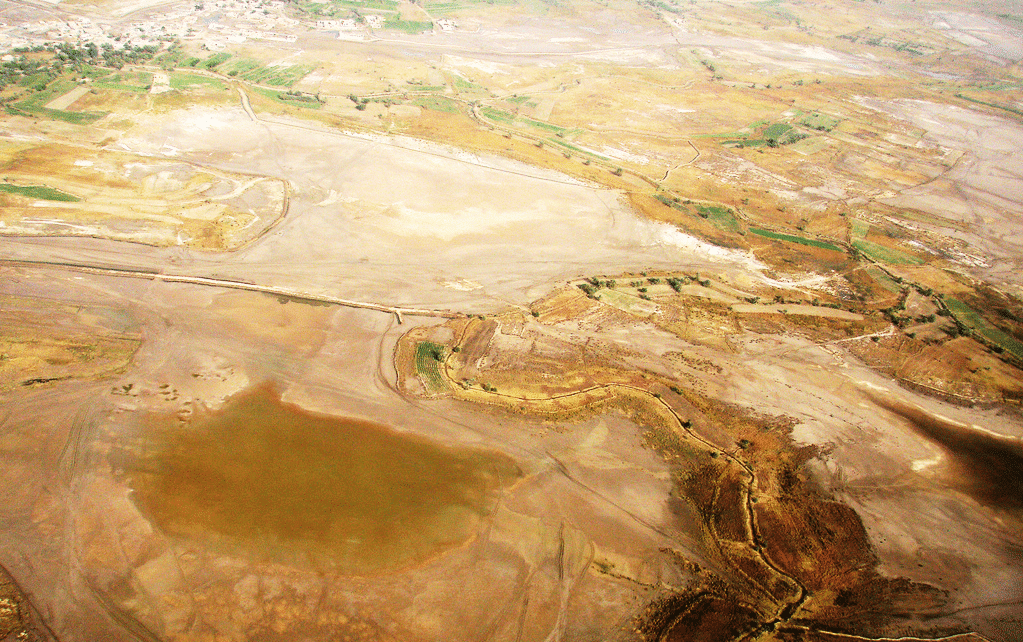 Image: Flickr, Drying Marshlands in Southern Iraq, Ken & Nyetta 2010
Image: Flickr, Drying Marshlands in Southern Iraq, Ken & Nyetta 2010
Fallow Fields, Fertile Ground for Unrest: Water Shortages Destabilize Iraq
Mesopotamia, the historic name for Iraq, means “the land between the rivers.” People in this region have shaped their lives around the Tigris and Euphrates for millennia. But, this summer, a combination of climate change, water mismanagement, and exploitation by neighboring countries has left both rivers unprecedentedly dry.
In June, water levels fell so low that people could cross the Tigris in Baghdad on foot. The water crisis caused a panic to sweep through Iraq, heightened by the government’s announcement that the cultivation of staple crops would be banned to conserve water. Now, as many analyses predicted, unrest has erupted across southern Iraq.
What are the broad security concerns?
Southern Iraq is rich in oil, but its people are mostly poor and agrarian. When these farmers lose their livelihoods, they join the 2.1 million displaced people already straining Iraq’s resources.
People from Iraq’s southern region also make up the majority of the Popular Mobilization Forces (PMF) that has been fighting IS. As the terrorist group is beaten back, southern Iraqis are coming home to a devastated, dried-out countryside. Some of them choose not to come home at all, preferring to stay in militias many Iraqis fear could become a parallel force threatening the state.
What’s happening now?
On the night of Friday, July 13, the shortages of water, jobs, and electricity sparked violent unrest in southern Iraq. Demonstrators attacked government infrastructure, set fire to political offices, and declared the ruling Shiite political parties responsible for their plight.
Thousands of protesters marched on government buildings in the cities of Amara, Babil, Basra, Karbala, Kut, Najaf, and Nasseriyah. After Friday’s upheaval, the Iraqi government cut off Internet access across the region in an attempt to contain the violence, and ordered security forces to remain on high alert. At least two protesters were killed by security forces this week.
What really caused the water shortage?
Southern Iraq is particularly susceptible to environmental destabilization. Once covered by 15,000 square kilometers of marshland, just 5,000 square kilometers of these economically and ecologically essential wetlands remain. The large-scale drying is happening for three major reasons: climate change, water mismanagement, and exploitation by neighboring countries.
Temperatures in the Middle East are rising twice as fast as the world average. This year, 97% of Iraq has been affected by heat waves and drought, contributing to the overall water shortage. Rainfall has become more irregular in recent years, changing the way Iraqis have farmed for generations.
Most Iraqi farmers still irrigate their crops using the ancient Mesopotamian method: dirt channels dug in between fields. This practice is outdated and inefficient, using large quantities of water while contributing to deteriorating soil quality, lower crop yields, and ultimately desertification. Iraqi officials are aware of this issue and have prepared a comprehensive plan for modernizing the country’s irrigation practices. However, the $184 billion needed to execute this plan is about the same amount as the country’s GDP. The very ministry that developed the project has stated that the money simply “is not available.”
Finally, freshwater inflows from the Tigris and Euphrates rivers have decreased significantly due to extensive damming and diversion by Syria, Turkey, and Iran. 70% of Iraq’s water flows from these neighboring countries, which have exploited the rivers since the 1970s – and Iraq pays the price. Inflows for 2018 were already 40% below the median when Turkey began filling a new dam on the Tigris. Turkey insists that the Ilisu dam has nothing to do with this year’s water shortages, but Iraqi officials blame the dam for reductions of up to 50% in the Tigris’ inflow.
What should the U.S. do about it?
Iraqi stability is essential to U.S. security interests. Our country has invested over $2.2 trillion in Iraqi security since 2003 – access to water and resiliency in the face of climate change are key parts of that security. The U.S. should act through international institutions to support the technical and financial assistance needed to modernize Iraq’s irrigation system.
Additionally, we should caution our NATO ally Turkey about its dam-building efforts that could further reduce freshwater inflows to Iraq. The Ilisu dam is only a small part of Turkey’s hydroelectric ambitions, which include the construction of 22 dams on the Tigris and Euphrates.
If no action occurs, the Tigris and Euphrates could completely dry up by 2040, permanently destabilizing the region and pushing Iraq even further toward chaos.





